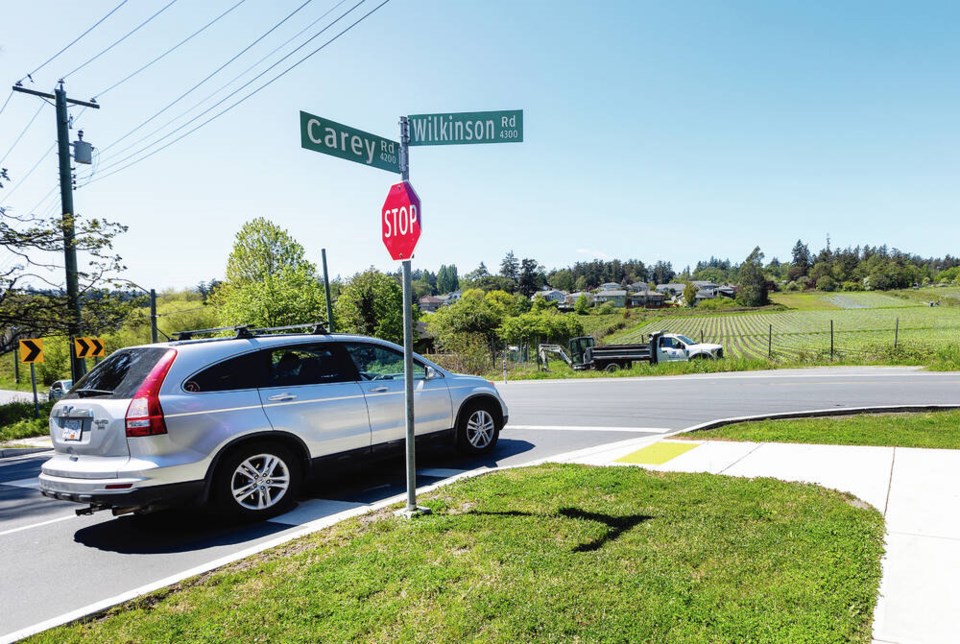The District of Saanich’s new Official Community Plan was adopted Tuesday, despite opposition from two councillors concerned about the future of the urban containment boundary, which protects rural land from most forms of development.
During lengthy deliberations before the plan was adopted by a 7-2 vote, Coun. Judy Brownoff said new wording in the document seems to make it easier to expand the urban containment boundary.
Under the previous policy, she said, bylaws or resolutions allowing a major expansion to the urban containment boundary could not be adopted without assent via referendum or plebiscite. The new wording, however, says major changes to the urban containment boundary can be considered if it’s the outcome of a review of the regional growth strategy.
“Taking away the assent of the electors through a referendum and plebiscite takes away their votes to protect our areas outside the urban containment boundary and farmland and the environment and so many other issues,” she said.
Coun. Nathalie Chambers, who also voted against adoption of the OCP, said while she agrees with “density in certain areas at certain times,” she’s concerned about creating “density ghettos that create heat domes without trees.”
“This plan does not give me confidence that it’s a stronger plan for the environment.”
Mayor Dean Murdock, however, said he doesn’t see the wording change in the OCP as a significant shift.
“I think around the council table, we all consider the urban containment boundary the no-go area. We want to keep our growth compact and inside the urban environment boundary and not encroaching on the rural and agricultural lands.”
Many councillors, speaking in favour of adopting the OCP, cited protection of the urban containment boundary as one reason they could support it.
Coun. Teale Phelps Bondaroff said maintaining the boundary is essential. “We know that urban sprawl damages ecosystems, that it impinges upon our farmland and it’s not an efficient use of land,” he said. “I think this council will continue to fight to protect the urban containment boundary.”
The newly minted plan, which has been two years in the works and marks the first update to the OCP in 16 years, incorporates new demographic information and updates land-use policies.
It directs higher-density development along main corridors, allowing for 18-storey residential towers along street corridors such as McKenzie Avenue and Quadra Street, the Tillicum-Burnside area and around McKenzie Avenue and Shelbourne Street.
It incorporates new provincial legislation that increases permitted building heights around transit hubs and allows denser housing forms such as houseplexes of three to six units, townhomes or small apartment buildings on single-family lots.
Permitted building heights increase to 12 storeys from eight in Royal Oak and to six storeys from four in Broadmead Village.
The plan incorporates the three transit-oriented development areas identified by provincial legislation — the Uptown transit hub, Royal Oak exchange and University of Victoria — that will now have to align with new provincial regulations that require building-height minimums of up to 10 storeys within 200 metres of the exchange and up to six storeys within 201 to 400 metres.
The document aims to establish Saanich as a district of “15-minute communities,” where households are within a 15-minute walk of key amenities such as grocery stores and other services, employment, parks and natural areas.
Murdock noted the plan focuses growth around designated areas, protects trees in natural areas and prevents sprawl into rural areas.
“And outside the urban containment boundary, we’re going to add more homes in walking distance to schools, parks, shopping services where people can access high quality and frequent public transit,” he said.
“While the province has given us direction on creating more homes, we’re going to do that in a way that’s appropriate for Saanich. With this updated Official Community Plan, we’ll steer our growth in a way that creates more homes where it makes sense while protecting what we love about the community.”
Murdock said most of the concern he has heard over the last several months comes down to uncertainty about what change is going to look like.
“From my perspective, the OCP gives us a little more certainty about what we might expect from change. And so I think over the course of time, I think we’re going to find that the OCP is actually a very helpful document to guide our growth.”
He noted there will be no change overnight. “The OCP is really an enabler for a lot of other plans, policies, and initiatives to come forward,” he said. “It’s something that’s going to come gradually over the course of the next five, 10 or 15 years.”
Coun. Karen Harper emphasized that the plan will be amended regularly. “This is a step forward. Some people have said it doesn’t go far enough, but again, it’s a living document and we will be in a position to tweak it as time goes on.”
>>> To comment on this article, write a letter to the editor: [email protected]



